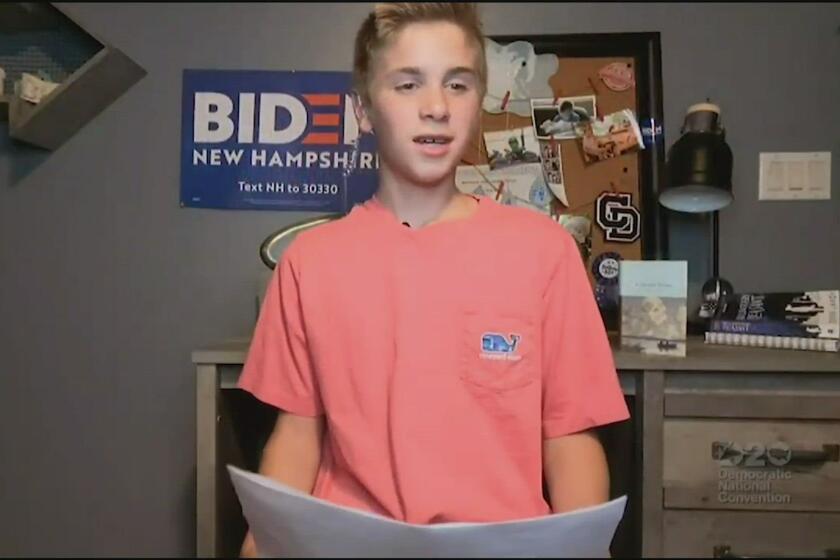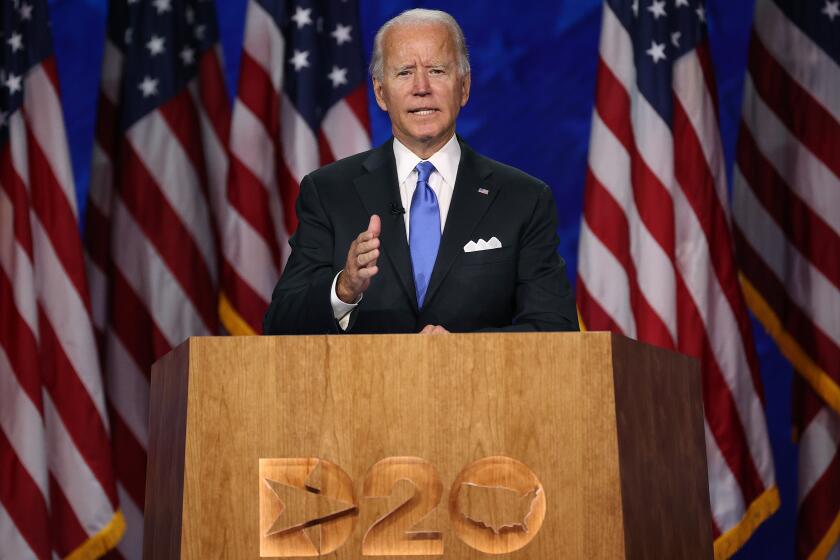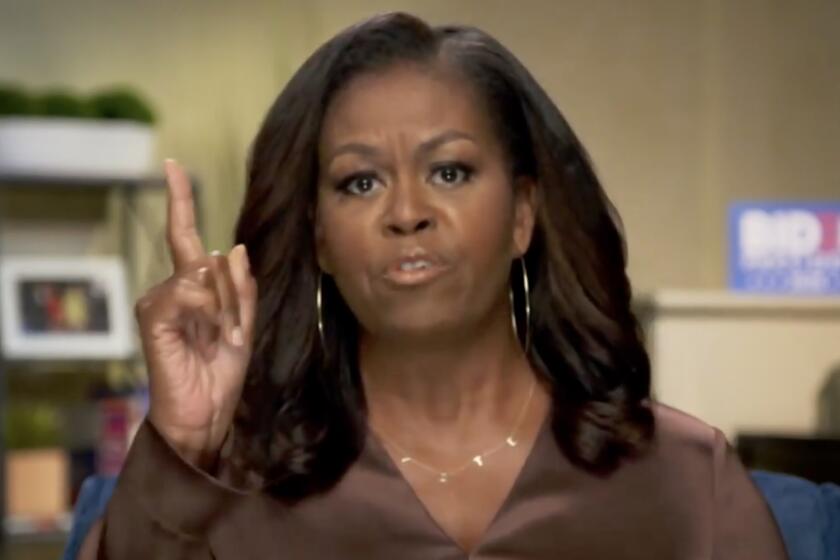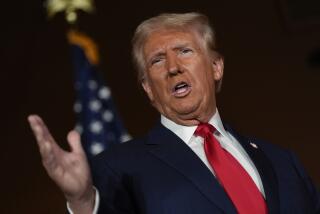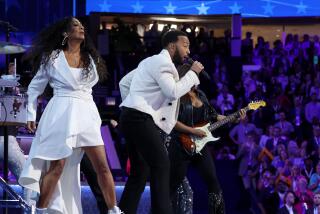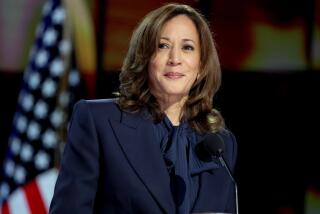Commentary: The traditional political convention is dead. Long live the virtual one
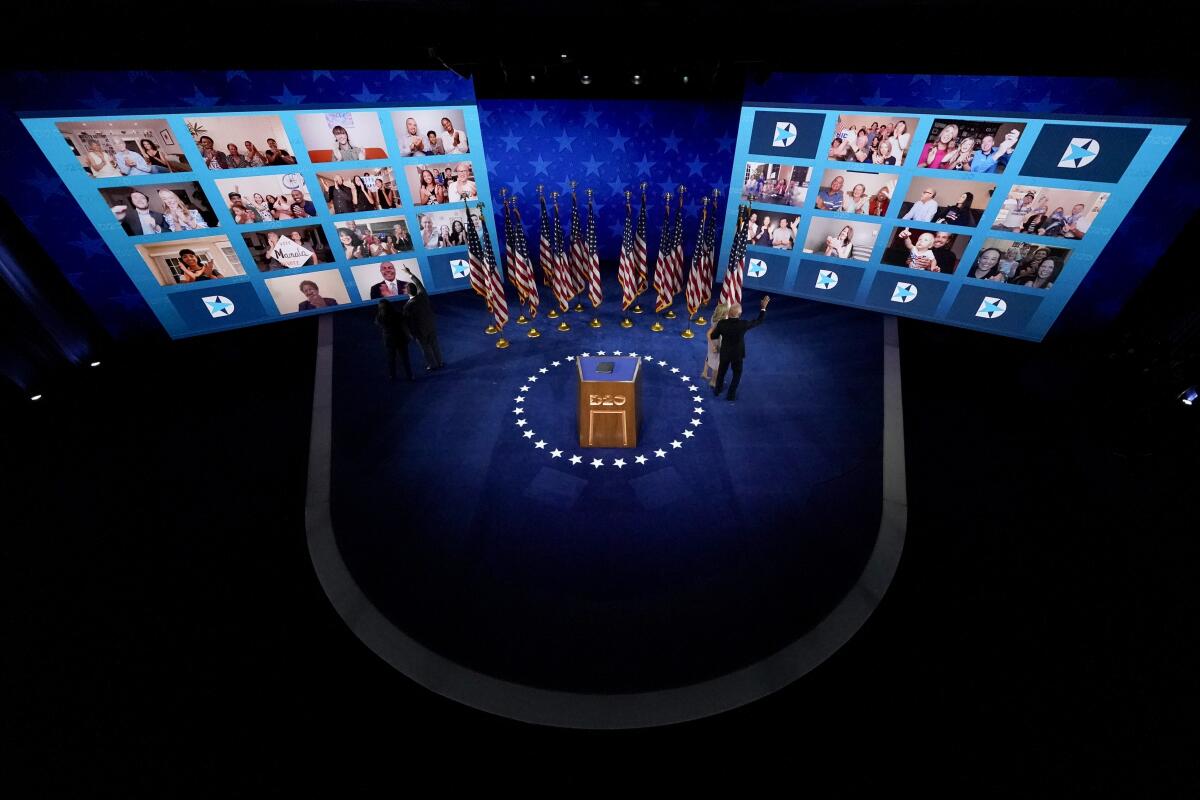
- Share via
The question of how to formally nominate a president and vice president during a pandemic has been answered.
Throw an unconventional convention, as the Democrats did this week for former Vice President Joe Biden and his running mate, Sen. Kamala Harris. Invite celebrities to host, then pepper the proceedings with testimonials from real folks, career politicians and NBA stars alike. Soldier through the perils of both live TV and video conferencing, namely pixelated computer camera interviews, ungainly moments of dead air, awkward missed cues and frozen smiles. Never mind that it may look more like a telethon, Zoom meeting or YouTube concert than an election-year function. It’s 2020. The world’s on fire. Do the best you can.
But a funny thing happened on the way to unmitigated political disaster. This week’s Democratic National Convention was more engaging than any of these quadrennial rituals has been in ages.
If there’s an upside to the pandemic — other than dining moving outdoors — it’s that both parties have had to rethink how they address the American electorate. And let’s hope they never go back to the way it was, even when it’s safe to convene again.
The Republicans will have the chance to put their spin on Washington’s newest tradition when they launch their own convention to nominate President Trump and Vice President Mike Pence on Monday, but the DNC led the way in showing that best way to appeal to a changing landscape is to change with it.
Conceived under duress, the four-night event worked because it was forced to deviate from political theater as usual. Its organizers turned a critical function of our democracy into a made-for-TV spectacle, and as blasphemous as it may sound, it was simply more compelling to watch than the fusty, arena-bound version that rolls around every four years.
The “virtual” convention pushed the Beltway to embrace the 21st century, and cater to its changing demographics, in all sorts of exciting and uncomfortable ways.
Brayden Harrington eloquently made the case for Joe Biden. How a “regular kid” delivered the most gripping moment of the Democratic National Convention.
Originally scheduled to be held last month at the Fiserv Forum in Milwaukee, the DNC was moved to August and downsized to the city’s Wisconsin Center as part of the party’s coronavirus-adjusted plan for the festivities. The new venue became a control center for the convention’s mix of prerecorded segments and live broadcasts, most of which were piped in remotely from across the U.S. And each night’s programming was two hours long, significantly shorter than conventions of yore. The truncated proceedings were a gift when one considers how difficult it is to focus on anything these days. Watching an endless procession of speakers take the same stage to harp on how broken things are sounds about as appetizing as bobbing for apples in a community bucket at a crowded fair.
Balloon drops don’t pack the wow factor they once did. And let’s face it: Both parties were scrambling to connect long before COVID-19 demanded social distancing. No one should ever have to see Clint Eastwood converse with an empty chair again.
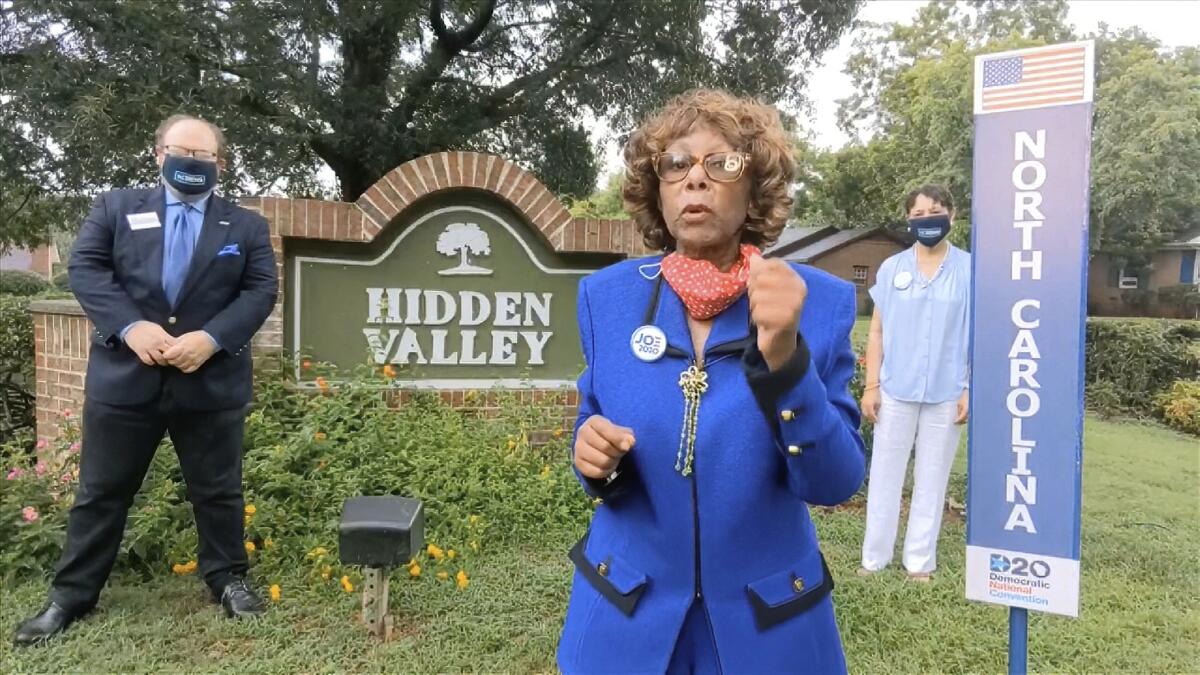
This week’s convention was a mix of high- and low-tech, taped testimonials from ex-presidents, political activists and musical performers that included Jennifer Hudson and an odd-couple duet by “Pose” star Billy Porter and rock icon Stephen Stills. Yet some of the best moments were watching people like you and me reacting to speeches from former First Lady Michelle Obama or Sen. Bernie Sanders from their living room sofas. They were beamed in from all over the nation, and many were given the space to speak personally about their concerns for the future — and, of course, why they believed Joe was the best guy to fix those problems.
TV viewing of Joe Biden’s acceptance speech fell 21% short of the 29.8 million who watched Hillary Clinton’s address when she was nominated in 2016.
The first-person format was surprisingly powerful. It beat listening to another statesman reiterating the same old stump speech, replete with anecdotes about “hard-working Americans.” No longer reduced to the “middle-aged Black woman,” “older white man” and “young Latino” of party focus groups and polling demographics, the words of the people in “We the people” rang true.
Strange as it felt compared to what we’re used to, it would have been much stranger to watch zealous crowds cavorting in silly hats while Rome burns.
A pandemic death toll of more than 170,000, an economic downturn, systemic racial injustice, uprisings against that injustice, the rise of white supremacy, attempts to dismantle the postal service, global warming and everything else that keeps us up at night and asleep midday. As moderator Julia Louis-Dreyfus’ unexpectedly sharp and widely criticized jokes at the start of Thursday’s program suggested, the week’s tone had to balance on a knife’s edge — and conventioneers dancing in the aisles would have been wholly inappropriate during a year that clearly wants to eat us alive.
It remains to be seen whether Trump’s TV savvy and affinity for disrupting norms will make his party’s effort to reimagine age-old tradition similarly successful. The format and line-up for the forthcoming week of red state revelry — which shifted away from in-person plans well after the DNC did — has not been officially announced, but it will reportedly feature rising stars in the party such as former U.N. Ambassador Nikki Haley, Sens. Tim Scott and Joni Ernst, and South Dakota Gov. Kristi Noem. Other speakers will include Nicholas Sandmann, who sued media outlets for libel over the way they covered his 2019 confrontation with a Native American group on the National Mall; and Mark and Patricia McCloskey, the Missouri couple who earlier this summer brandished guns outside their home when Black Lives Matter protesters marched in their neighborhood.
The still-white Democratic establishment is happier making memes of Black women than actually adopting policies to better their lives.
It’s safe to say there won’t be any former presidents or first ladies speaking on Trump’s behalf as the Obamas, Clintons and Carters did for Biden, though. He also won’t have the celebrity wattage that Democratic tickets are renowned for attracting; in addition to Louis-Dreyfus, the DNC moderators were Eva Longoria, Tracee Ellis Ross and Kerry Washington.
The Republicans have their own issues to contend with, which if listed here would take three days to read, so let’s just stick with the logistics. The delegate roll call vote is one such hurdle: They must translate the lengthy, dry Washington process into a sexy — at least watchable — live event, or risk putting millions of viewers to sleep.
The Democrats’ winning answer was to pair each vote tally announcement with video segments from all the states and territories. Figures representing the regions read the count aloud and commented on politics of the kitchen-table variety. It produced one of the week’s most viral moments when Joseph McNamara, of what he called “the calamari comeback state of Rhode Island,” presented his state’s delegate count next to a plate of the fried appetizer.
No one can blame voters for wanting a delectable morsel alongside one of this country’s starchiest political traditions — and now that we’ve had a taste of what the convention can be when it’s unbound from the old rules, there should be no going back.
More to Read
Sign up for Essential California
The most important California stories and recommendations in your inbox every morning.
You may occasionally receive promotional content from the Los Angeles Times.
